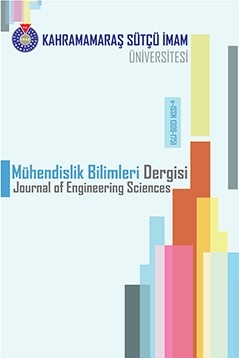TEKSTİL ATIKSUYU VE SENTETİK BOYARMADDE ÇÖZELTİLERİNDEN RENK VE KOİ GİDERİMİNDE ALÜM VE MAGNEZYUM KLORÜRÜN KARŞILAŞTIRILMASI
koagülasyon, flokülasyon, adsorpsiyon, magnezyum, renk
COMPARISON OF ALUM AND MAGNESIUM CHLORIDE IN COLOR AND COD REMOVAL FROM TEXTILE INDUSTRY WASTEWATER AND SYNTHETIC DYEING SOLUTIONS
coagulation, flocculation, adsorption, magnesium, color,
___
- [1] Cinar, O., Demiroz, K., 2010. Biodegradation of azo dyes in anaerobic-aerobic sequencing batch reactors. In: Atacag Erkurt, H. (Ed.), Biodegradation of Azo Dyes, Handbook of Environmental Chemistry, vol. 9. Springer Verlag, Berlin/Heidelberg, pp. 59–72.
- [2] Pala, A., Tokat, E., 2002. Color removal from cotton textile industry wastewater in an activated sludge system with various additives. Water Research 36 (11), 2920-2925.
- [3] Marmagne, O., Coste, C.,1996. Colour removal from textile plant effluents. American Dyestuff Reports 85,15-21.
- [4] Gao, B.Y., Yue, Q.Y., Wang, Y., Zhou, W.Z., 2007. Color removal from dye-containing wastewater by magnesium chloride. Journal of Environmental Management 82,167-172.
- [5] Hai, F.I., Yamamoto, K., Fukushi, K., 2007. Hybrid treatment systems for dye wastewater. Critical Reviews in Environmental Science and Technology 37, 315-377.
- [6] Robinson, T., Mcmullan, G., Marchant, R., Nigham, P., 2001. Remediation of dyes in textile effluent: a critical review on current treatment technologies with proposed alternatives. Bioresource Technology 77, 247-255.
- [7]Verma, A.K., Dash, R.R., Bhunia, P., 2012. A review on chemical coagulation/flocculation technologies for removal of colour from textile wastewaters, Journal of Environmental Management, 93, 154-168.
- [8]Rice, E.W., Baird, R.B., Eaton, A.D., Clesceri, LS., 2012. Standard Methods for the Examination of Water and Wastewater, Washington.
- [9]Kayranli, B., 2011. Adsorption of textile dyes onto iron based waterworks sludge from aqueous solution; isotherm, kinetic and thermodynamic study. Chemical Engineering Journal, 173, 782-791.
- Başlangıç: 1998
- Yayıncı: Kahramanmaraş Sütçü İmam Üniversitesi
Metin SALİHMUHSİN, Mehmet EKER
TERMİK SANTRALLERİN MRV SİSTEMİ SERA GAZI EMİSYON HESABI ve EMİSYONLARIN İYİLEŞTİRİLMESİ
NORMAL KATILAŞTIRMA YÖNTEMİ İLE ÜRETİLEN Al-Mg-Ti-B ALAŞIMININ MİKROYAPI VE MEKANİK ÖZELLİKLERİ
Hakan YAYKAŞLI, Musa GÖĞEBAKAN
DA-DA YÜKSELTEN DÖNÜŞTÜRÜCÜ İLE ELEKTRİKLİ ARAÇ BATARYA ŞARJ CİHAZI TASARIMI
SOĞUTUCULARDA AKIŞKAN MİKTARI VE KILCAL BORU EBATLARININ ODA SICAKLIĞINA ETKİSİNİN İNCELENMESİ
Mustafa ATMACA, Savaş EKŞİOĞLU, Ender YILMAZ
Çiğdem ŞAHİN DEMİR, Ali UÇURUM, Ahmet EFE
